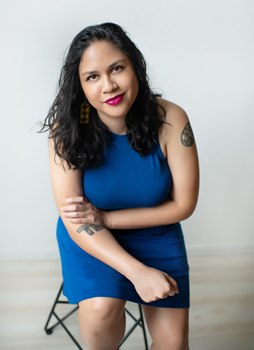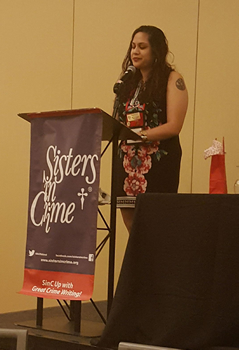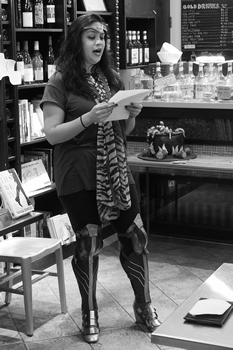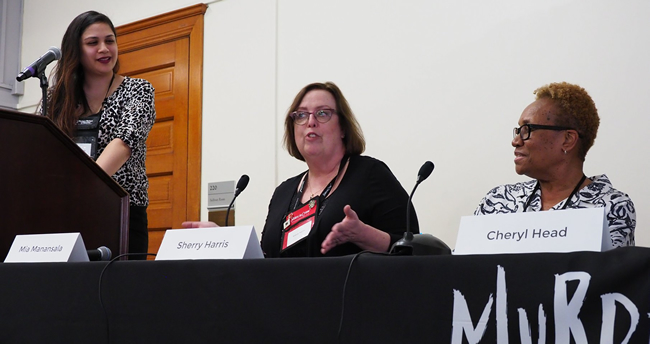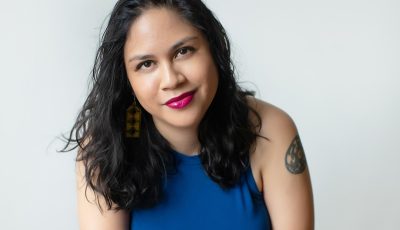

On the Cover: Mia P. Manansala
Filipino Food with a Side of Murder Makes for an Appetizing Read
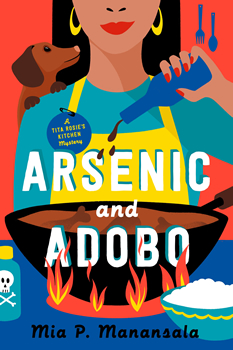 By Karen Hugg
By Karen Hugg
Author Mia P. Manansala’s earliest memories of food were of eggs and rice. “Sometimes with a side of cheap processed meat, fried until crisp and tasty,” she says. She grew up in a big family eating “frugal but delicious” meals with a father who cooked, spawning a lifelong love of food. Even the first mystery she ever read was Encyclopedia Brown Takes the Cake, a kids’ book of mini mysteries with accompanying recipes. Later as an adult, Manansala deepened that passion for food while living and traveling in Asia. She taught English in South Korea for over three years, visited Cambodia and Japan, and spent time with family in the Philippines.
Now, that rich life comes together in her debut novel, ARSENIC AND ADOBO, a title referencing a killer poison and a savory sauce. It’s a cozy mystery with a fun conversational tone and endearing Filipino family at its heart. Twenty-something Lila Macapagal has given up her dream of owning a café in Chicago to help out at her aunt Rosie’s restaurant in the small town of Shady Palms. But when Lila’s high school sweetheart falls dead in his bowl of ginataang bilo-bilo, Lila must find the killer before the local detective charges her with murder.
In this The Big Thrill interview, Manansala talks about her early years in a bustling ethnic family, her favorite Filipino dishes, and the importance of writing communities.
I loved how the story of ARSENIC AND ADOBO skipped along through the eyes of a warm, down-to-earth narrator. It was as if I, the reader, was Lila’s girlfriend for a few days, experiencing everything she went through in solving this murder. Did anyone in real life inspire that character?
This is going to sound strange, but her original inspiration was an alternate version of me. I grew up in a working-class/lower middle-class neighborhood of Chicago that was majority Latinx. However, the Filipino parties we attended for my parents’ friends were in the suburbs and tended to be at these really lavish (to my young mind) houses. For a kid where a fridge that had an ice machine was my idea of luxury (still don’t have one), going to a house that had a spiral staircase absolutely blew my mind. My household was large, but I didn’t have a big extended family in the area, whereas these people had tons of aunts, uncles, cousins, etc. in the surrounding area and at school with them. They were also in majority White neighborhoods, and my brothers and I often struggled to find common ground with the kids at these parties. Everyone was kind, and we had fun, but we definitely felt like outsiders, despite these people being our godmothers, godfathers, and general kin.
So I wanted to imagine what it’d be like if I grew up in an area like that. How would my family change? Who would I be? My protagonist’s family couldn’t have money, it didn’t feel natural to me, but I wanted to see what growing up in that general environment would be like. That’s where the character started, but she quickly grew into her own person.
As a girl growing up in a Polish family in a Polish neighborhood in Chicago, I instantly identified with Lila’s ethnic life and her extended family. Did you grow up in Chicago with a large, tight-knit, Filipino family or in a small town more like Shady Palms?
Hello, fellow Chicagoan! As I mentioned earlier, I grew up in a large household in Chicago. We all lived in my maternal grandparents’ house: my grandparents, my parents, my two younger brothers, my two cousins, and me. Sometimes, other family and friends would live with us temporarily if they needed a place to stay. I think it’s common for immigrant families to be that way, where family/friends who are new to the country or experiencing certain difficulties stay with us for some time until they’re stable enough to strike out on their own.
Beyond Lila’s Filipino family, the book reflects the wonderfully diverse cultures of America. From the half-Korean Dr. Jae to Yuki, Elena, the Bishops and Kostas, and her Muslim friends Adeena and Amir. Did you know you wanted to include this mix when you started the book, or did it come about more gradually and randomly?
I knew it was going to be a diverse book because that’s what my world looks like. That’s what my friend groups are like. It wasn’t me trying to check off boxes—I wanted a cozy setting that finally reflected the world that I live in and never get to see.
Food takes a spotlight in this book. Reading about all of the yummy Filipino dishes (and otherwise) made me hungry! What are some of your favorite dishes?
I could talk about food all day! My favorite Filipino dish is kare-kare, which might be a hard sell to Western audiences. It’s an oxtail and tripe dish cooked in a peanut sauce with eggplant, long beans, and a leafy green similar to bok choy that I can’t remember. It’s often served with a side of fermented shrimp paste (which I LOVE) and is amazing heaped on top of mounds of white rice. It’s somewhat similar to panang curry in flavor.
The Philippines also has some amazing soups, and one of my faves that I grew up with is sinigang. It’s a light, tangy soup full of veggies and your choice of protein (shrimp is my favorite), delicious by itself or with a bowl of rice. The souring agent varies depending on region and family recipes, but I grew up with the kind that came out of a Mama Sita’s packet, flavored with tamarind.
Just like Lila, I have a bit of a sweet tooth, and the Philippines has an amazing array of sweets. One of my faves is the fluffy brioche-like bun known as ensaymada. It has several versions, but my favorite is topped with butter, sugar, and grated cheese. Absolutely addictive.
Cooking is really about love and community. Did you grow up cooking with your parents or other relatives?
My father was the cook in the family, and ARSENIC AND ADOBO is dedicated to him. He’s the one who got me obsessed with food. He was a real old-school cook, not really relying on recipes, and our kitchen was too small for me to be in there with him. My brothers and I were often relegated to prep duty, most often wrapping lumpia (Filipino spring rolls). I started cooking more Filipino food after he passed away, but it’s not the same. He was the master.
What are some of your best (or worst) memories associated with sharing a meal?
Not to generalize too much, but many Asian cuisines are served in communal ways because they’re meant to be enjoyed with family and friends. Some of my happiest memories involve sitting around sharing hot pot with my closest friends, eating and laughing over a meal that lasts for hours.
You have three dogs but none, at least currently, are dachshunds like Longganisa. Did you ever have a dachshund, or was she a product of your imagination?
I want a dachshund so bad, but my husband’s not a fan. I’m trying to get him to change his mind so I can have my own real-life Longganisa! I’ve never had one, but I think they’re adorable. I knew there had to be a dog in my book, and I thought it would be cute to have a wiener dog named after one of my favorite foods, a short, fat Filipino sausage.
How did you know this book would be a cozy and not a more serious murder mystery? Do you read cozies yourself, and if so, who are your favorite cozy mystery authors?
The idea for this book, or at least the opening scene, came from a joke between me and Kellye Garrett that cozies were just rom-coms with dead bodies. I really like to lean into humor, so I knew that a lighter subgenre was necessary. Plus, my mom and I are big cozy fans, so I wanted to write the book we always wished we could find on the shelves.
Some of my fave cozy and traditional mystery authors are Kellye Garrett, Gigi Pandian, Vivien Chien, V. M. Burns, Alexia Gordon, and Naomi Hirahara. I also really enjoyed Esme Addison’s debut and am looking forward to the sequel. My publisher, Berkley, is doing an amazing job with its newer Millennial line, with its focus on younger, diverse protagonists and stories, with authors like Olivia Blacke, Jennifer J. Chow, and Abby Collette.
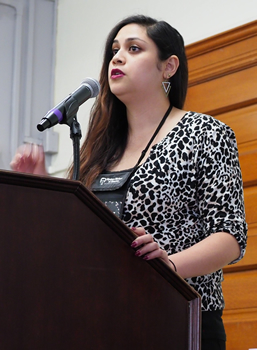
Manansala directs the Q&A for the Kinder, Gentler Murder panel at Murder and Mayhem 2019 in Chicago.
You mentioned that you’re a “joiner” and belong to several community groups. What do community groups, writing or otherwise, mean to you?
I’m an introvert (as I think many writers are), but I’m also a big believer in community and people coming together to help and uplift each other. Writing can often feel like such a lonely, isolating endeavor, but it doesn’t have to be. I wouldn’t be where I am now if people like Lori Rader-Day and Kellye Garrett hadn’t reached out a hand to pull me up with them. I wouldn’t have made it through the ups and downs of debuting during a global pandemic without the community I’d already built plus my beloved Berkletes (fellow Berkley Publishing 2021-2022 debut authors) hyping me up, giving a space to vent, and overall being one of the best support systems I’ve ever had.
I truly believe that you owe it to everyone who helped you along the way to do the same for someone who’s a little further behind you on their writing journey. It costs you nothing to be kind, but it means everything to the person receiving that kindness.
You also were mentored via the Pitch Wars program. Can you talk about your experience with that? Do you advise newer writers to participate?
I absolutely advise newer writers to participate! For those of you not familiar with Pitch Wars, the site describes the program as “a mentoring program where published/agented authors, editors, or industry interns choose one writer each, read their entire manuscript, and offer suggestions on how to make the manuscript shine for an agent showcase. The mentor also helps edit their mentee’s pitch for the contest and their query letter for submitting to agents.” It’s meant to prepare you for the industry, so you apply to work with specific mentors the way you would an agent: with a finished manuscript, prepared sample pages, query letter, and synopsis.
You might’ve noticed Kellye Garrett’s name all over this interview, and that’s because she was my mentor back in 2017. She taught me so much about craft and the industry, and she’s gone on to not only be a co-mentor with me, but one of my closest friends.
Every mentor/mentee team has their own style, but she is the Plotting Queen and basically had me tear my book apart and construct a stronger, tighter narrative. I re-wrote at least two thirds of the book over three separate revisions during the roughly three-month mentoring period. The book we worked on got me several offers and my first agent (we’ve since parted ways), but unfortunately that book never sold. However, I took what I learned from my time in Pitch Wars and moved on to my next book, which is now my debut.
What’s ahead for Lila and Tita Rosie in coming books?
I currently have a three-book contract, so Book 2 is with my editors right now (Homicide and Halo-Halo, tentative release date February 2022!) and involves a deadly small-town beauty pageant that stirs up uncomfortable memories of Lila’s past. I’m writing Book 3 now, and it currently involves a visitor with strong ties to Tita Rosie, so she’ll be a big part of that book, and I already feel so bad for her. Fingers crossed I get to write more than these three books because I love these characters and the world of Shady Palms so much!
- Debut Spotlight: Roxana Arama - January 31, 2023
- International Thrills: Claire Douglas - August 1, 2022
- Up Close: Timothy David Mack - March 31, 2022

